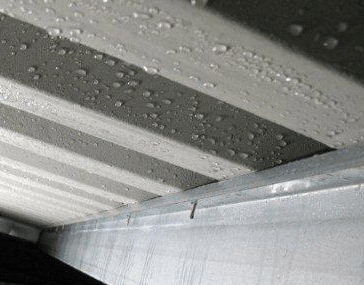When it comes to roofing materials, metal roofs have gained popularity for their durability, energy efficiency, and aesthetic appeal. However, like any roofing system, they are not without their issues. One common problem that metal roof owners may face is condensation under the metal roof. In this article, we will delve into the causes, effects, and solutions for condensation under a metal roof to help you understand and address this issue effectively.

What is Condensation Under a Metal Roof?
Condensation under a metal roof occurs when moisture in the air transforms into liquid water on the underside of the roof’s metal panels or sheathing. This happens when warm, moist air comes into contact with a cold surface, causing the moisture to condense into water droplets. This condensation can lead to various problems if left unaddressed.
Causes of Condensation Under Metal Roofs
Understanding the causes of condensation under metal roofs is crucial for preventing and managing the issue. Here are some common factors that contribute to this problem:
- Temperature Difference: The most significant cause of condensation under metal roofs is the temperature difference between the interior and exterior of the building. During cold weather, the interior of the building is heated, while the metal roof remains cold. This temperature contrast promotes condensation.
- High Humidity: Regions with high humidity levels are more prone to condensation issues. The moisture in the air can infiltrate the building’s interior and condense on the cold metal roof.
- Inadequate Ventilation: Poor ventilation in the attic or under the metal roof can trap moist air inside, increasing the likelihood.
Effects of Condensation Under Metal Roofs
Condensation under a metal roof can lead to several detrimental effects, including:
- Damage to Insulation: Excessive condensation can saturate insulation material, reducing its effectiveness and promoting mold growth.
- Corrosion: Prolonged exposure to moisture can lead to corrosion of the metal panels, weakening the roof’s structural integrity.
- Mold and Mildew: Moisture buildup provides an ideal environment for mold and mildew growth, which can compromise indoor air quality and pose health risks.
Solutions for Condensation Under Metal Roofs
Dealing with condensation under a metal roof requires a systematic approach. Here are some effective solutions:
- Proper Ventilation: Ensure your attic or the space beneath the metal roof is adequately ventilated. Proper ventilation helps maintain a balanced temperature and humidity level.
- Vapor Barriers: Installing a vapor barrier between the interior space and the metal roof can prevent moisture from reaching the cold surface.
- Insulation: Use high-quality insulation materials that are resistant to moisture and consider adding more insulation to reduce temperature differences.
- Regular Inspections: Periodic inspections of your metal roof can help detect condensation issues early, allowing for timely intervention.
- Professional Assistance: If you’re unsure how to address condensation problems, consult with a roofing professional who can assess your specific situation and recommend appropriate solutions.
Conclusion
In conclusion, condensation under a metal roof is a manageable issue with the right knowledge and preventive measures. Understanding condensation causes, effects, and solutions ensure a durable, moisture-free metal roof. Regular maintenance and professional guidance are key to a long-lasting and trouble-free metal roofing system.



Leave a Reply